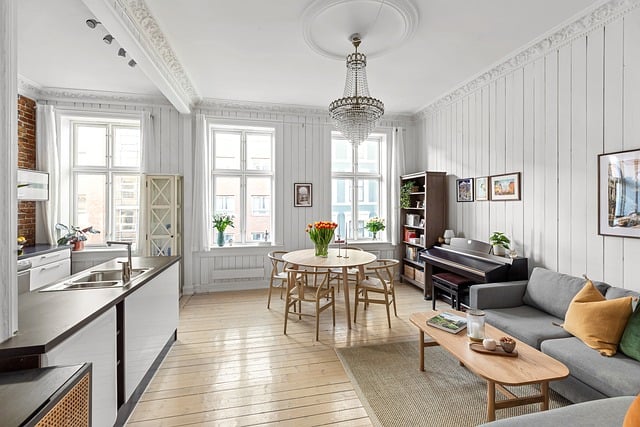Biophilic design is an approach that seeks to connect building occupants more closely to nature. This design concept uses natural elements such as light, vegetation, water, and materials to create more productive and healthier built environments. Biophilic design is becoming increasingly popular due to its numerous benefits for physical and mental well-being.
The Principles of Biophilic Design
Biophilic design is grounded in several core principles:
Direct Connections with Nature
This includes elements like indoor plants, water features, and views of nature. These direct connections can improve mood, reduce stress, and enhance overall well-being.
Indirect Connections with Nature
Indirect connections involve using natural materials, colors, and patterns that mimic nature. This can include wood, stone, natural fabrics, and patterns inspired by natural forms.
Natural Light and Ventilation
Maximizing natural light and ensuring good ventilation are essential. These elements help regulate circadian rhythms, improve air quality, and enhance comfort.
Sense of Space and Place
Creating spaces that feel expansive and are connected to their surroundings fosters a sense of place and belonging. This can be achieved through thoughtful spatial design and layout.
Critical Trends in Biophilic Design for 2025
Increased Use of Sustainable and Eco-Friendly Materials
There is a growing emphasis on using sustainable, recycled, or locally sourced materials. This benefits the environment and adds a natural aesthetic to interiors.
Integration of Advanced Technology with Natural Elements
Innovative technology is being integrated with biophilic design to enhance comfort and functionality. This includes automated lighting that mimics natural light patterns and climate control systems that respond to outdoor conditions.
Multi-Functional Spaces Designed to Enhance Well-Being
Spaces are being designed to serve multiple purposes, such as work, relaxation, and socialization, all while incorporating elements of nature to improve well-being.
Focus on Mental Health and Stress Reduction
Designers are increasingly focusing on how biophilic design can support mental health. Natural elements create calming environments that help reduce stress and anxiety.
Biophilic Elements and How to Incorporate Them
Indoor Plants and Vertical Gardens
Plants are a cornerstone of biophilic design. Indoor plants and vertical gardens can purify the air, add beauty, and create a sense of tranquility.
Natural Materials
Using materials such as wood, stone, and bamboo brings a touch of nature indoors. These materials add texture, warmth, and a sense of authenticity to spaces.
Water Features
Water features like fountains and aquariums provide a soothing sound and a dynamic visual element. They can be incorporated into various areas of the home or office.
Natural Light
Maximizing natural light through large windows, skylights, and strategic placement enhances the connection to the outdoors and improves mood and productivity.
Nature-inspired art and Decor
Art and Decor that depict natural scenes or use natural materials can reinforce the biophilic theme. This includes paintings, sculptures, and textiles with nature motifs.
Case Studies: Successful Biophilic Designs
Residential Spaces
Examples of homes that have successfully integrated biophilic principles include those that extensively use indoor plants, natural materials, and open layouts that enhance natural light.
Commercial Spaces
Offices, hotels, and retail environments are adopting biophilic designs to create more inviting and productive spaces. Features like green walls, indoor trees, and natural materials are commonly used.
Public Spaces
Parks, libraries, and community centers are embracing biophilic design to create more welcoming and engaging environments for the public. This includes the use of natural light, plants, and water features.
Practical Tips for Implementing Biophilic Design at Home
Assess Your Space: Start by evaluating your space and identifying areas where biophilic elements can be added. Look for opportunities to introduce plants, natural materials, and more natural light.
Choosing the Right Plants: Select plants suitable for your indoor environment. Consider factors like light levels, humidity, and maintenance requirements.
Incorporating Natural Materials and Colors: Use wood, stone, and natural fabrics. Choose colors inspired by nature, such as greens, browns, and blues.
Enhancing Natural Light and Ventilation: Maximize natural light using large windows, skylights, and light-colored walls. Improve ventilation by ensuring good airflow and using air-purifying plants.
Balancing Technology and Nature: Integrate innovative technology to complement your biophilic design. Use bright lighting, climate control, and automated systems to enhance comfort and functionality.
Challenges and Considerations
Maintaining Indoor Plants: Indoor plants require regular care, including watering, pruning, and monitoring for pests. Choose low-maintenance plants if you have a busy lifestyle.
Balancing Design Elements: Balancing biophilic design with modern aesthetics can be challenging. Aim for a harmonious blend that integrates natural elements without overwhelming the space.
Addressing Allergies and Sensitivities: Some people may be allergic to certain plants or natural materials. To minimize issues, choose hypoallergenic options and ensure good air quality.
Sustainability and Ethical Sourcing: Ensure your materials and plants are sustainably and ethically sourced. This supports environmental conservation and fair trade practices.
The Future of Biophilic Design
The future of biophilic design looks promising, with continued innovations and a growing emphasis on sustainability. Emerging trends include using bio-based materials, advanced technology for indoor farming, and biophilic urban planning. As awareness of the benefits of biophilic design grows, we can expect it to become an integral part of architecture and interior design.
Conclusion
Biophilic design is more than just a trend; it is a holistic approach to creating healthier and more inspiring living environments. By incorporating elements of nature into indoor spaces, we can enhance well-being, productivity, and overall quality of life. Embrace biophilic design to create spaces that nurture the human spirit.



